19 Types of Trees in Georgia (With Pictures)
-

- Last updated:

Georgia may be famous for its peaches, but even more impressive are its limitless landscapes. After Alaska, Georgia has the most forest land area1 of any state, boasting over 24 million acres of unsullied nature.
That’s a lot of space for a vast and varied collection of tree species. And for homeowners, it signifies an incredible opportunity to bring native charm to their backyard. Discover the diversity and scenic splendor with this quick glimpse at 19 types of trees in Georgia.
The 19 Types of Trees in Georgia
1. Red Maple

| Habitat: | Bottomlands and swamps |
| Height: | 40–60 feet |
| Spread: | 24–35 feet |
The deciduous red maple (Acer rubrum) makes an attractive shade tree in Georgia backyards. You can find it growing naturally in moist soils throughout the state, in valleys above the Piedmont region, and in low areas and swamps in the Coastal Plain. It can tolerate adverse growing conditions when it gets adequate irrigation.
The red maple’s green leaves turn a striking red or yellow color as fall approaches. The bark is light gray and smooth but breaks up as the tree ages. Tiny red flowers grow in early spring before drooping twin seeds emerge, sporting inch-long wings.
2. Flowering Dogwood

| Habitat: | Fertile, well-drained soil |
| Height: | 15–20 feet |
| Spread: | 15–30 feet |
As one of the most popular ornamental trees in the eastern United States, the medium-growing, shade-tolerant flowering dogwood (Cornus florida) is a staple in Georgia landscaping. Showy white or pink blooms present gorgeous displays from March to April before giving way to bright red fruits. Leaves turn an attractive scarlet hue in the fall, making this deciduous tree rich in color for the entire year.
3. White Ash
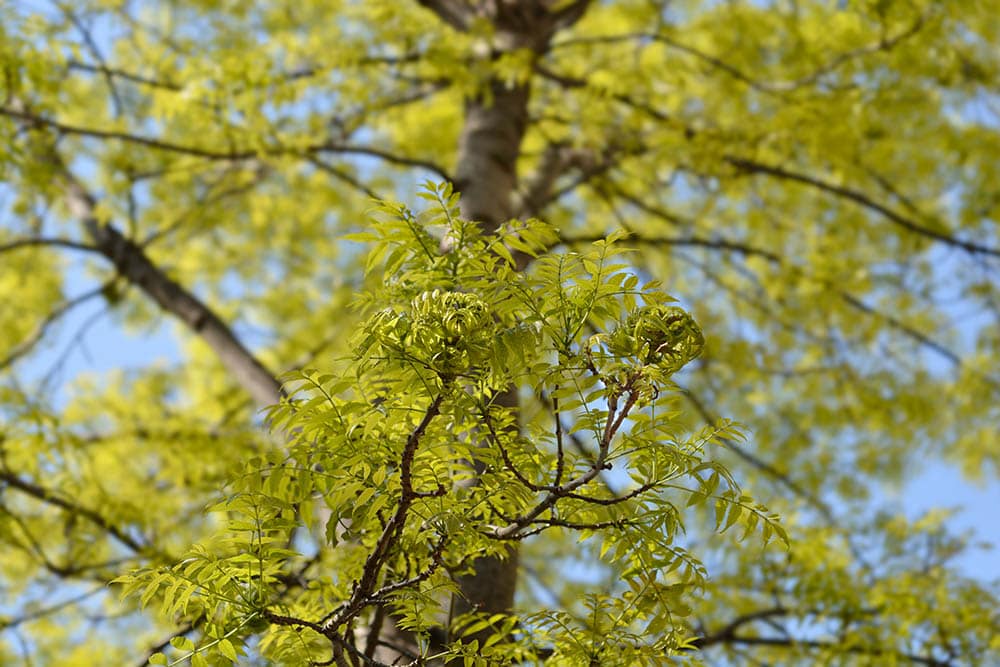
| Habitat: | Moist, well-drained forests |
| Height: | 50–80 feet |
| Spread: | 50–80 feet |
The white ash (Fraxinus americana) is a straight-growing tree with a rounded or conical crown of leaves. It grows throughout the state, particularly in the upper forest above the Piedmont region, enjoying rich, moist forest soils. White ash is a critical commercial hardwood in Georgia and is common in sporting equipment and furniture.
Although white ash isn’t tolerant of poor growing conditions, it makes a delightful ornamental addition to a yard. The wide trunk and clean, rounded spread are handsome additions to parks and large yards. Green compound leaves hold 5–9 leaflets that turn from yellow to purple in the fall.
4. Hickory
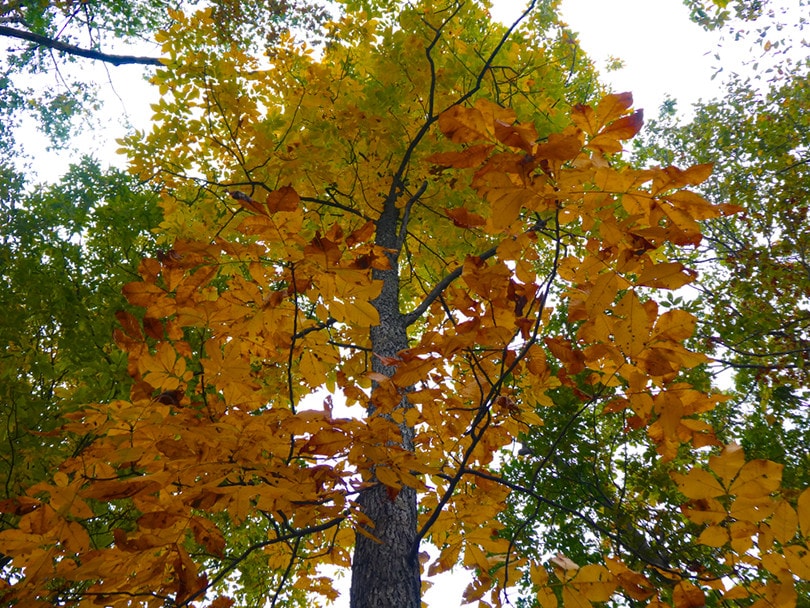
| Habitat: | Rich, moist bottomlands |
| Height: | 60–100 feet |
| Spread: | 40–75 feet |
Numerous hickory (Carya) varieties are common in Georgia, including shellbark, shagbark, bitternut, and Carolina hickory trees. These tall deciduous trees develop dense canopies of compound leaves, offering a wealth of shade to the streams and floodplains where they typically grow.
With a deep taproot and slow, tall growth, hickory trees aren’t ideal for landscaping, but they have numerous commercial uses. The wood is one of the densest in North America. The extreme hardness and gorgeous varied grain patterns make it a premium flooring option.
Alongside its durability, hickory has excellent shock resistance, a practical feature for baseball bats and other sports equipment. It also acts as fuel and a flavoring for smoking meats, and many cultivars grow sweet edible nuts.
5. Southern Magnolia
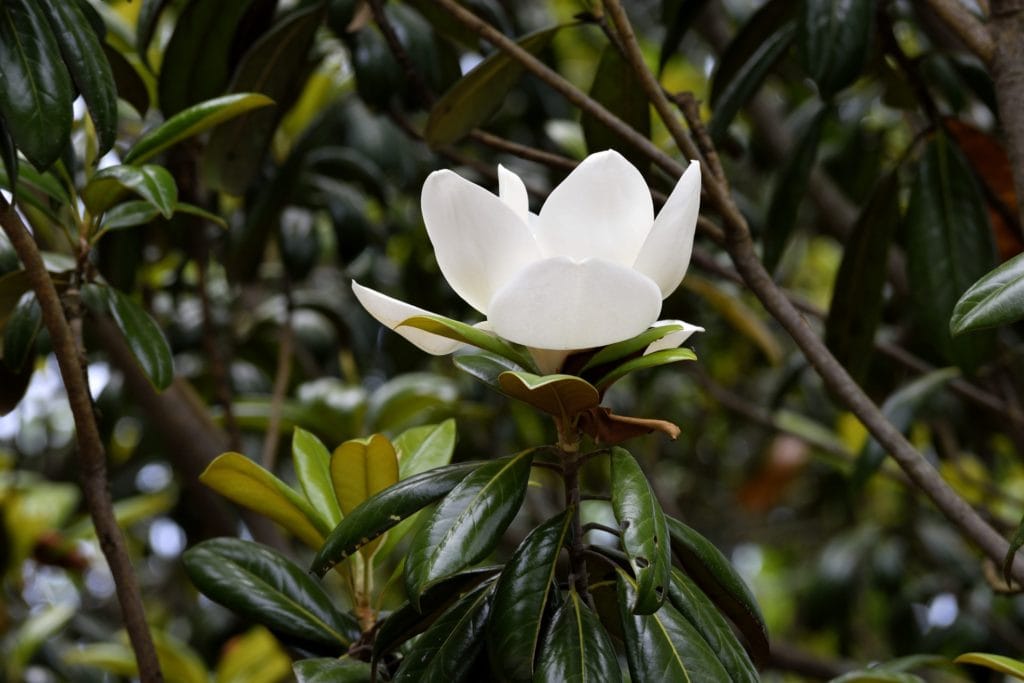
| Habitat: | Hardwood forests and swamps |
| Height: | 60–80 feet |
| Spread: | 40–50 feet |
Although it’s the Mississippi state tree, the southern magnolia (Magnolia grandiflora) is equally welcome in Georgia. Beautiful, creamy-white flowers bloom from May through June, bringing a delightful fragrance to the yard. It does not tolerate dry regions, so you’ll find this broadleaf evergreen in moist forests and swamplands, primarily around the Coastal Plains.
6. White Oak
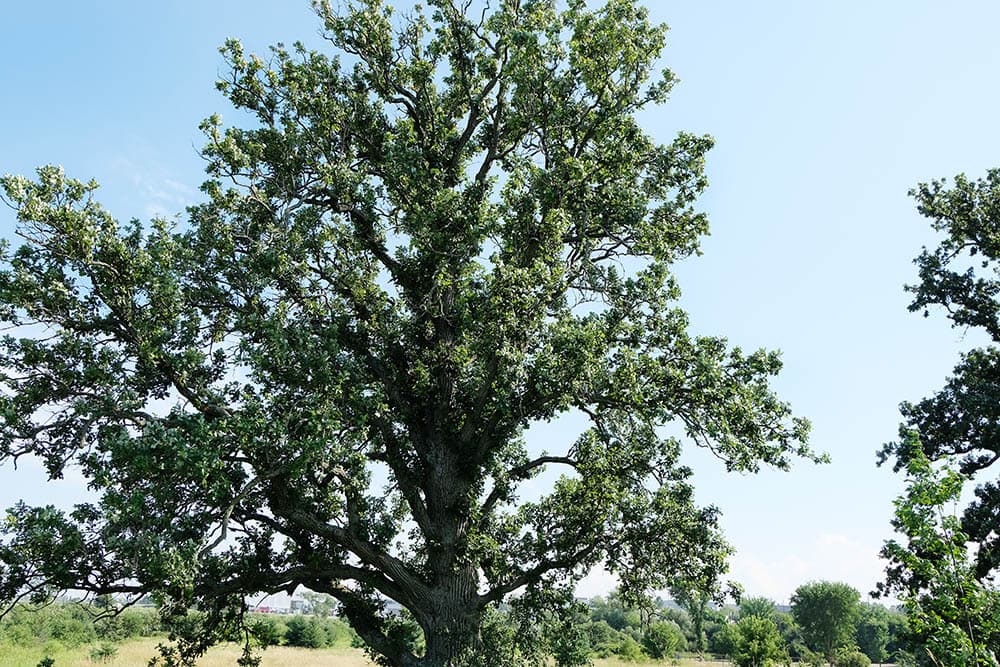
| Habitat: | Hardwood forests and swamps |
| Height: | 60–80 feet |
| Spread: | 40–50 feet |
Though it’s less common around the coast, the white oak (Quercus alba) is one of the most abundant oak varieties in northern Georgia. It grows in moist, well-drained soils in the Piedmont and mountain regions. Branches grow in an attractive oval or rounded spread, featuring light green leaves that transition to a rich wine color as winter approaches.
The slow–medium growth rate lends itself to creating a denser wood, and the white oak is one of the most valued hardwoods in Georgia. It’s popular across several industries, including fencing, flooring, and furniture-making.
7. Virginia Pine
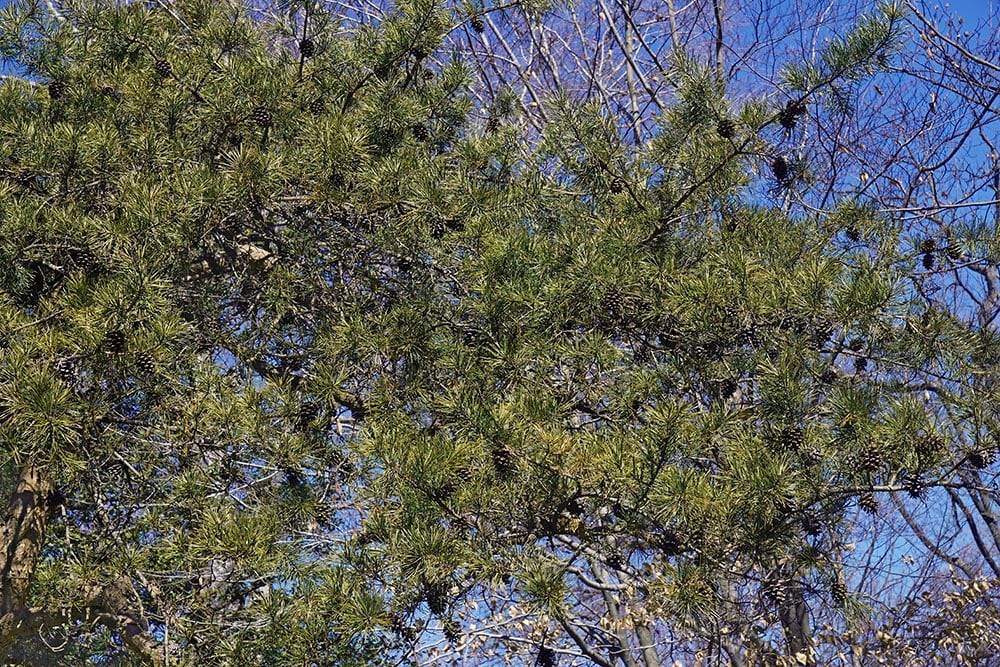
| Habitat: | Mountain regions |
| Height: | 40–70 feet |
| Spread: | 40–60 feet |
Despite being shorter than many other pines, the Virginia pine (Pinus virginiana) is one of the hardiest evergreen trees, growing well even in dry soil. It grows as a broad pyramid, often developing a flat top with age. Needles can grow up to 3 inches long, popping up in groups of two along the branches, and the fruit develops as prickly cones about 1–2 inches long.
While Virginia pines are primarily viable only as pulp, some people grow them for Christmas trees due to their dense branches and versatile growing habits. As such, they may need considerable pruning to overcome the scrubby appearance.
8. Water Oak
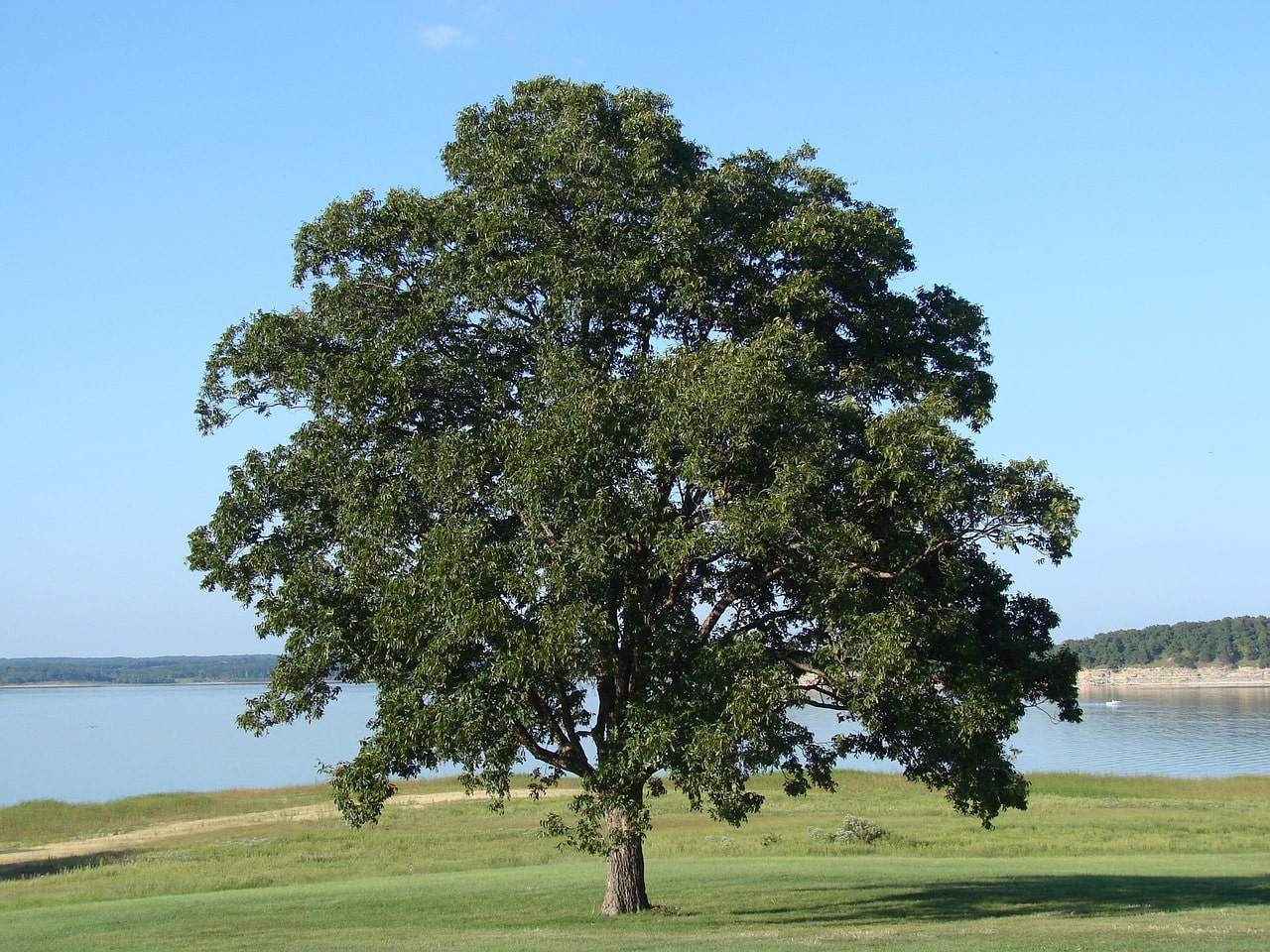
| Habitat: | Stream banks and low grounds |
| Height: | 50–80 feet |
| Spread: | 25–40 feet |
The water oak (Quercus nigra) is a faster-growing variety of oak, commonly found along the Coastal Plains up into the foothills. The wood is weaker than slow-growing oaks, and branches tend to break easily from ice and wind.
Water oaks have a notably short life span, only lasting 30–50 years. Still, the fast growth and dense canopy make it a suitable shade tree for many people. Paddle-shaped leaves grow in groups of three, turning from green to yellow in the fall. The semi-evergreen nature allows leaves to persist through winter, especially in the warmer parts of Georgia.
9. American Beech
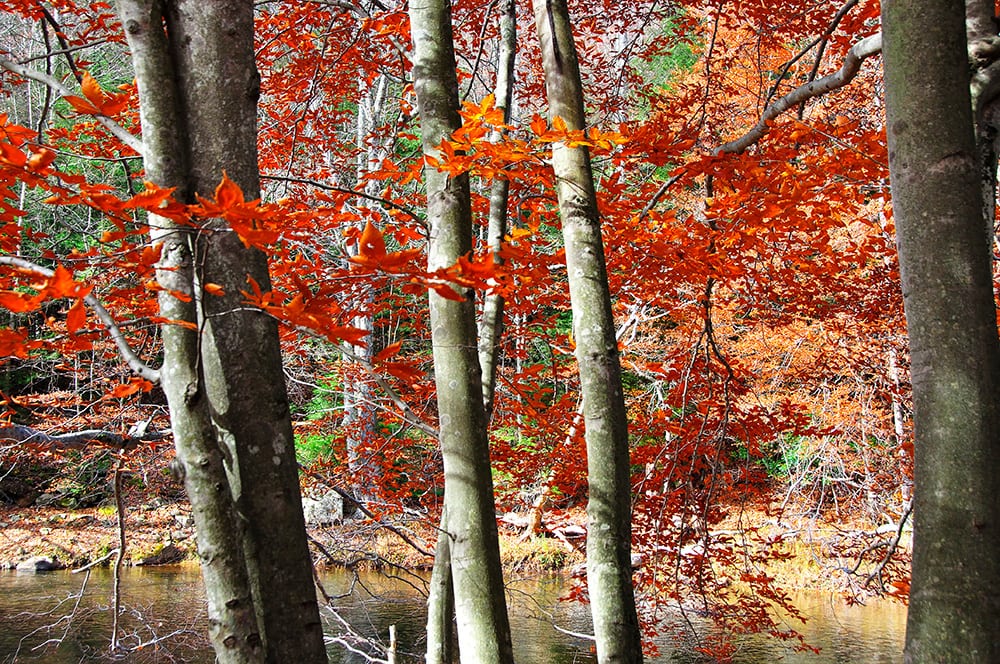
| Habitat: | Moist, rich soils along streams |
| Height: | 50–80 feet |
| Spread: | 40–60 feet |
The sturdy American beech (Fagus grandifolia) lives a long, healthy life as a prominent shade tree. The smooth bluish-gray bark retains its composition as it ages, and branches extend horizontally to create a wide canopy.
Dense shade, a thick trunk, and shallow roots prevent other plants from growing under or around the American beech tree. But while grass and other vegetation may not like it, birds and mammals love the tree for its abundant beech nut production.
10. Loblolly Pine
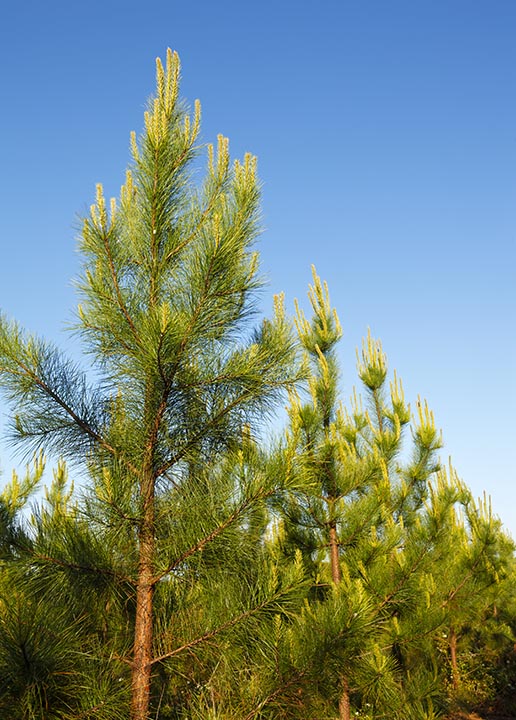
| Habitat: | Piedmont region |
| Height: | 80–100 feet |
| Spread: | 20–30 feet |
The loblolly pine (Pinus taeda) is a collection of slender features. The fast-growing evergreen can climb over 100 feet tall, sporting 6-inch-long cones and needles up to 10 inches long. As it grows, it tends to lose its lower branches. It settles with a rounded crown, allowing filtered light for plant growth beneath the canopy.
Loblolly pine is the most commercially valuable southern pine in Georgia. Producers harvest more loblolly pine than any other species in the Piedmont region, sending it for use in construction, finishing, and pulp.
11. Bald Cypress
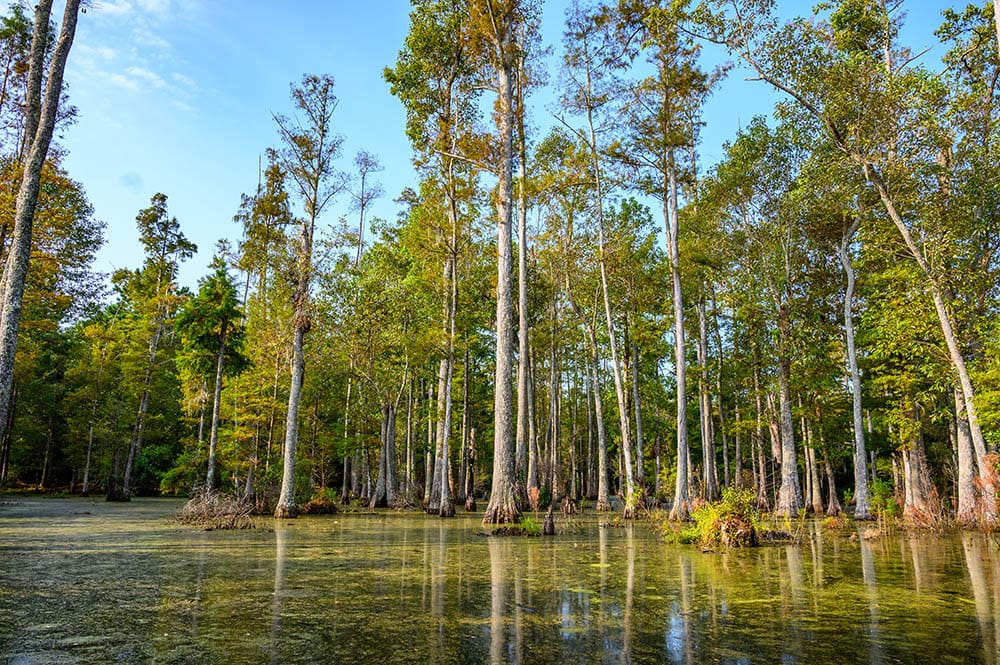
| Habitat: | Wet soils near swamps and streams |
| Height: | 60–100 feet |
| Spread: | 40–50 feet |
Bald cypress (Taxodium distichum) is an attractive landscaping tree in Georgia. Its bark divides into reddish-brown fibrous scales for a consistent highlight, and the feathery green leaves turn an elegant, rusty orange in the fall. The roots develop unique “knees” in poorly drained soils around the swampy areas where it tends to grow.
Gorgeous, adaptable, and pest-resistant, bald cypress is a practical landscaping tree. It also has many commercial uses, particularly where water is an issue, such as in docks and boats. The old-growth heartwood is notably resistant to moisture damage and rot, earning its reputation as “the wood eternal.”
12. Sweetgum
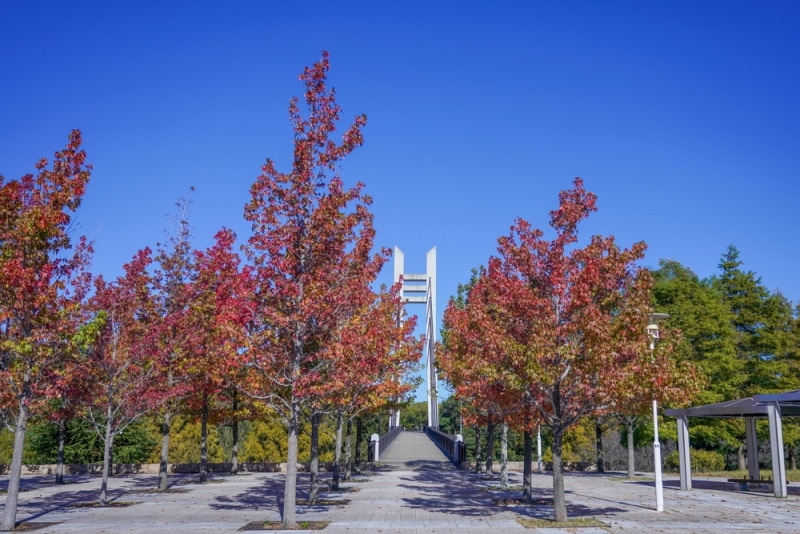
| Habitat: | Moist soils in valleys and floodplains |
| Height: | 80–100 feet |
| Spread: | 40–50 feet |
As an excellent specimen or shade tree, Sweetgum (Liquidambar styraciflua) is a deciduous tree that brings attractive fall colors to even the hottest Georgia areas. The tree is oval as it grows, but branches broaden outward when it matures while maintaining the conical head.
The sweetgum tree’s five-lobed, star-shaped leaves are a sensory pleasure. Leaves grow up to 6 inches long, taking on a gleaming green color in the summer before transitioning to stunning arrays of yellows, oranges, reds, and purples in the fall. The foliage even produces a pleasant aroma when you crush it.
13. Tupelo

| Habitat: | Moist soils in valleys and upland forests |
| Height: | 70–80 feet |
| Spread: | 40–50 feet |
Tupelo (Nyssa sylvatica), or black gum, is a dense, conical deciduous tree with horizontal spreading branches. Lustrous leaves make it an apt specimen for Georgia gardens. The glossy green leaves grow up to 5 inches long and take on a spectacular scarlet color in the fall.
The black gum tree is dioecious, and only the female produces fruit. Since the fruit is dark blue and sour, it’s a significant draw for birds and other wildlife.
14. Eastern Redbud

| Habitat: | Moist soils in valleys and hardwood forests |
| Height: | 20–25 feet |
| Spread: | 15–20 feet |
The eastern redbud (Cercis canadensis) is a delightful landscaping element, particularly when it flowers in March and April. The bright pink blooms overtake the tree to create a spectacular focal point.
Although it’s primarily found in moist soils along the hills and valleys of the Piedmont region, the eastern redbud can tolerate various growing conditions. Larger trees are challenging to transplant, but you can buy many young starters with different bloom colors available at local nurseries.
15. White Pine
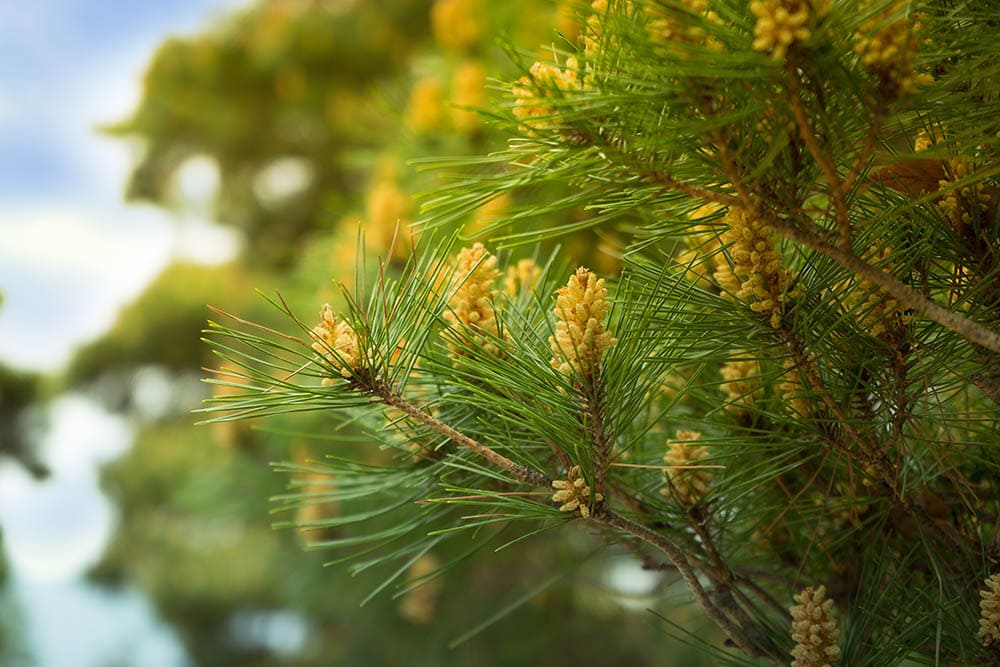
| Habitat: | Varies, primarily in mountainous northern regions |
| Height: | 50–80 feet |
| Spread: | 30–40 feet |
The eastern white pine (Pinus strobus) is a majestic evergreen species. As one of the tallest northeastern conifers, it can grow up to 100 feet tall in some instances, creating a widespread canopy. Branches grow perfectly horizontal, arranged in tiered steps. Commercially, its straight growth is advantageous for milling, making it a valuable construction material.
Though the white pine can grow in many different soil conditions, it is best for growing as a screen or specimen in the mountain regions. It can be quite short-lived in unfamiliar southern areas in the Piedmont and the Coastal Plains.
16. Scarlet Oak
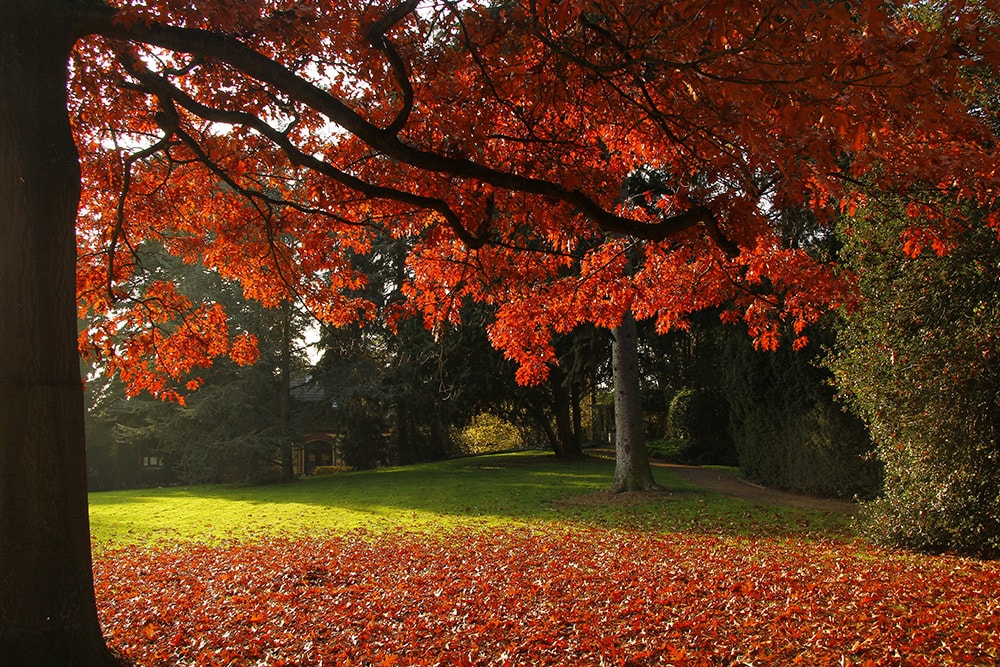
| Habitat: | Dry, sandy soils in uplands and Piedmont area |
| Height: | 60–80 feet |
| Spread: | 50–60 feet |
Named for its exquisite red fall foliage, the scarlet oak (Quercus coccinea) is a favorite shade tree in Georgia. It grows relatively fast, reaching heights of 100 feet or more in some cases.
From the finely cracked bark to the smooth twigs, every aspect of the scarlet oak has subtle reddish tints mixed with woody browns. Leaves can grow over six inches long to support up to nine lobes. Catkins develop alongside new leaves, while acorns ripen in the fall after maturing over two seasons.
17. Eastern Red Cedar
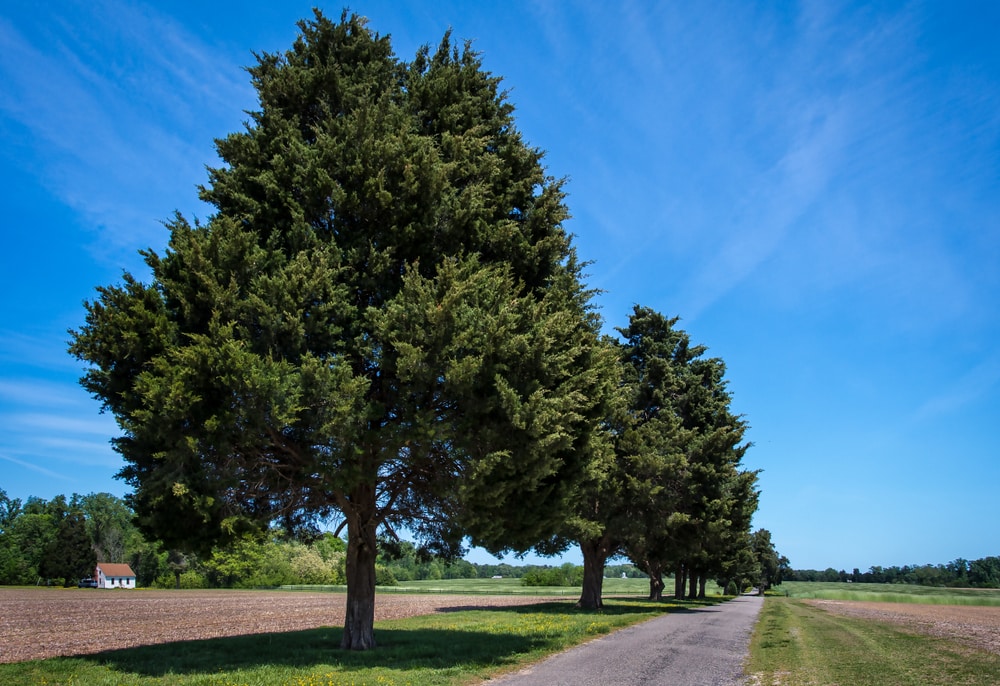
| Habitat: | Piedmont region through the northwest |
| Height: | 40–50 feet |
| Spread: | 8–20 feet |
Providing dense, shrub-like foliage and an aromatic essence, the conical eastern red cedar (Juniperus virginiana) is an exceptional specimen tree. It accepts many growing conditions, tolerating a range of pH levels and nutrient-deficient soils. The cedar is relatively low maintenance, offering a manicured look perfect for a windbreak or hedge.
18. Downy Serviceberry
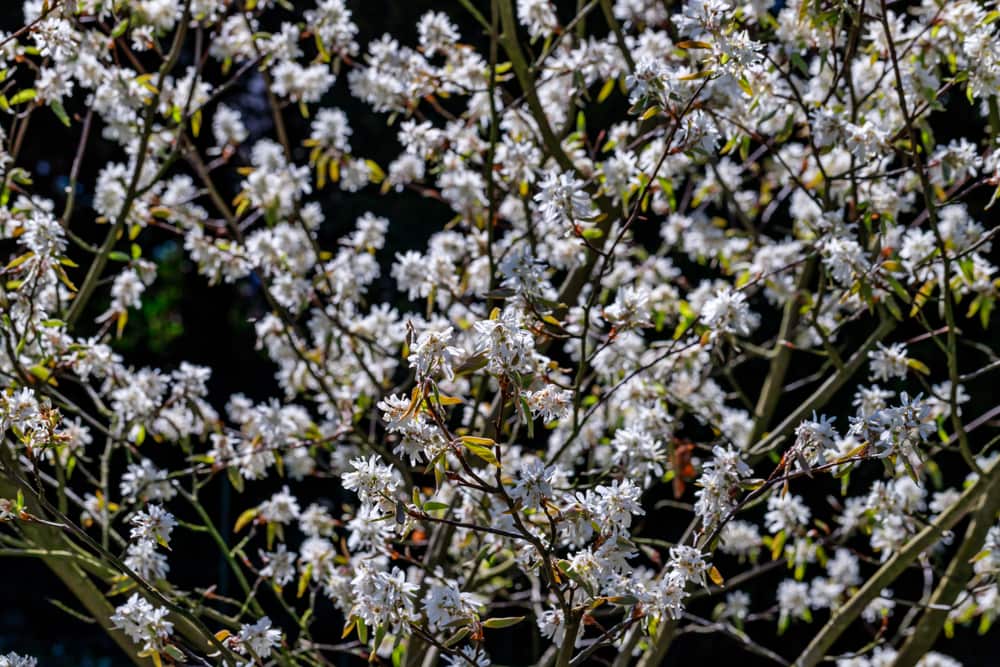
| Habitat: | Moist soils along streams |
| Height: | 15–25 feet |
| Spread: | 15–20 feet |
The flowering downy serviceberry (Amelanchier arborea) is a dainty deciduous tree that usually grows no more than 25 feet above its foot-wide base. Leaves develop covered in plush, woolly hair, giving it a down-like appearance. As they grow, the leaves smooth out to a yellowish-green, turning to warm yellow and red hues in the fall.
Ornamental white flowers arrive in early spring, descending in clusters during late March through April. Purple berries then emerge in the summer. They’re semi-edible for people, more ideal for jams than as a snack, but they are a big hit among the local wildlife.
19. Sassafras
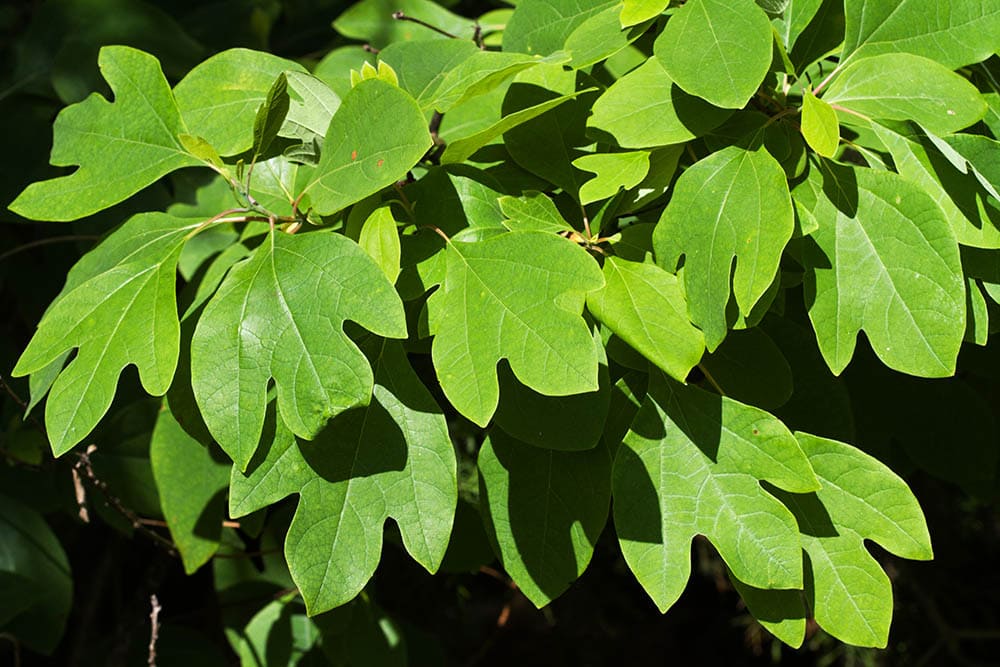
| Habitat: | Dry soils around old fields and forest edges |
| Height: | 35–50 feet |
| Spread: | 15–20 feet |
The attractive ridged bark, lush green foliage, and tiny sunbursts of yellow flowers in March make the sassafras tree (Sassafras albidum) a year-round delight. Leaves of 1–3 lobes grow up to 6 inches long, turning dark green in summer and vibrant oranges and reds in fall.
Dark blue fruits grow at the end of bright red stalks on female plants after flowering, attracting various birds to the yard. Traditionally, the tree’s roots supplied the flavor for root beer, and many people use them today to make therapeutic teas.
In Conclusion
From the northern mountains to the Coastal Plains, Georgia features an endless assortment of ecosystems and unique plant life. We’ve only touched the tip of the iceberg when discussing the hundreds of tree species found across the state. But hopefully, it has given a little perspective on the immense possibilities for beautifying your landscaping at home.
See Also:
- 9 Types of Grass in Georgia – Top Choices for Your Lawn (With Pictures)
- 17 Best Flowers to Grow in Georgia (With Pictures)
Featured Image Credit: 1195798, Pixabay
Contents

